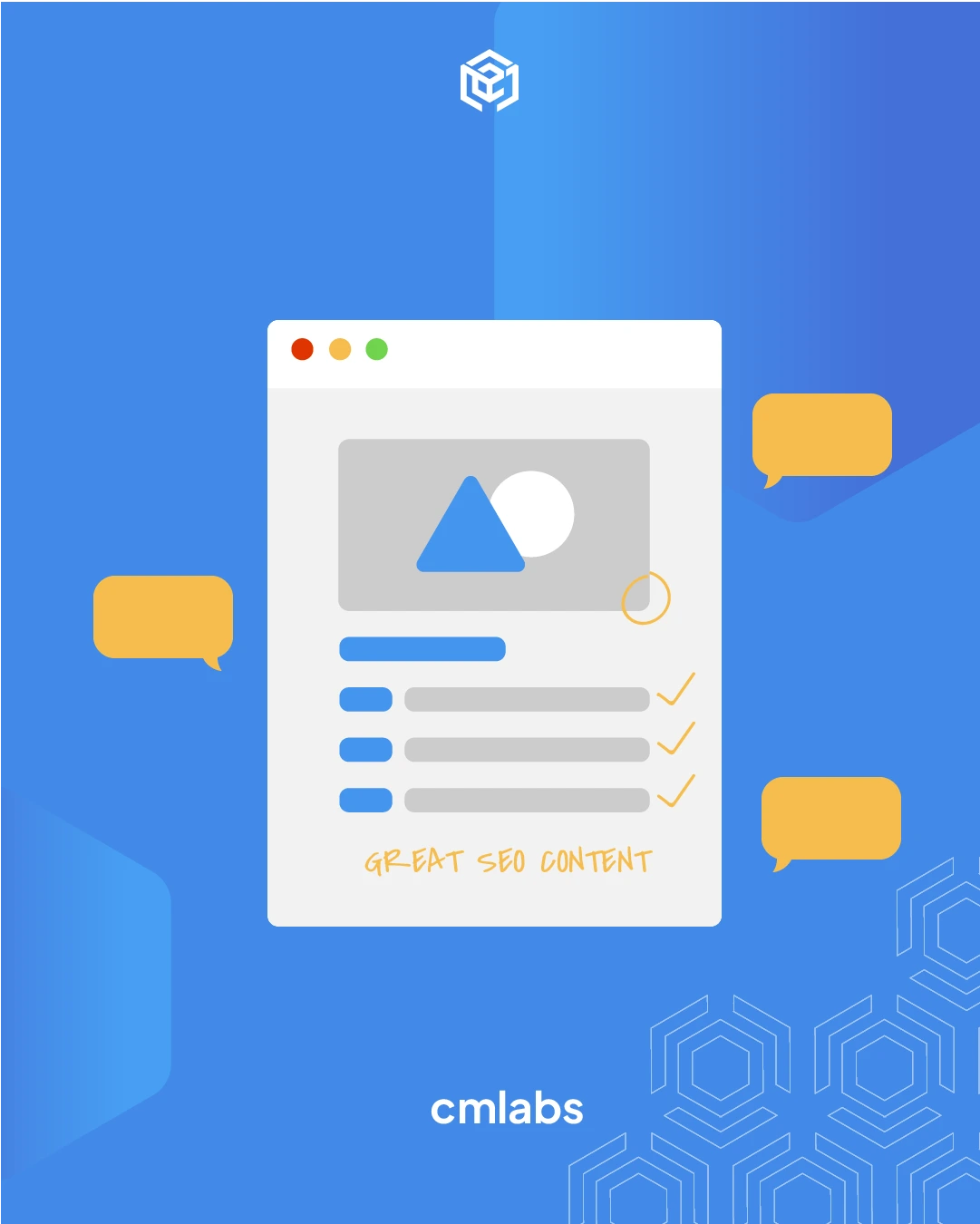We use cookies
This site uses cookies from cmlabs to deliver and enhance the quality of its services and to analyze traffic..
SEO SERVICES
Conduct in-depth technical website audits, strategically develop website projections, and increase your website authority.
ASO SERVICES
Elevate Your App’s Presence with Our Expert ASO Services – Boost Visibility and Drive Downloads!
WRITING SERVICES
We offer a variety of writing services to suit different business necessities. Reach broader audiences or lead specific industries? We've got you covered!
Get relevantly positive media exposure from bloggers and online publishers to increase your brand mentions on search engine results pages.
SEOlutions
A unified source of truth!
SEO & Digital Maternity Solution
SEO & Digital Maternity Solution: Leverage Cross-Platform Insights to Elevate Your Strategy with Expert Consultation
SEO & Digital Maternity Solution
Data Solution options:
Starting from Rp200 mio
Reinventing how a company get creative treatments
A new way to get your creative needs done. Agile team, efficient cost, and expedient way in a flexible yet scalable subscription plan!
Creative-as-a-Services
CaaS package options:
Based on Subscription
Pioneer in digital marketing software powerhouse
We’re excited to unveil our new range of Tech Solutions designed to drive your digital success. Whether you’re looking to enhance your website’s performance, streamline your tech stack, or unlock deeper insights from your data, we’ve got you covered.
Starting from Rp250 mio
Our Clients
Research and innovation center for digital transformation
Digital marketing combines technical skills and business knowledge at every stage. For marketing teams, improving budget management efficiency is crucial, as time is an invaluable resource that should be used wisely. At Sequence, we are dedicated to empowering you to optimize efficiency and strategic planning, ultimately enhancing the impact of your digital marketing efforts.
Subscription-based (IDR1,800/keyword)
Our Clients
BeyondSEO
References
SEO Tools for Webmasters
SEO Tools for Writers
SEO Tools
FIND THE SUITABLE PARTNERSHIP FOR YOUR COMPANY
Check out which cmlabs partnership program suits your company
WHITE LABEL SEO
for CorporateYour company is granted exclusive partnership rights to provide SEO services to our important clients, and we will provide a dedicated backend team to support your efforts.
AFFILIATE PROGRAM
for BizdevA new affiliate program is being introduced for skilled marketers and individuals with strong networks, offering commissions of up to 7% for generating profits independently.
DIGITAL AGENCY
for Marketing Partnerscmlabs is an essential partner for digital agencies, providing a unique selling proposition in Search Engine Optimization (SEO).
BACKLINK PARTNERSHIP
for Media / BloggerWe have a vast database of bloggers and media outlets across Indonesia, categorized by region and media type, giving our clients an edge in managing their media and SEO activities.
OFFICIAL TRAINING
We provide ongoing professional development and support to SEO professionals to ensure they are equipped to meet market demands.
JOIN AS CONTRIBUTOR
for Content WriterGreat opportunity for SEO Writers around the world. T&C applied!
ACADEMIC PARTNERSHIP
Through partnerships with universities in Indonesia, cmlabs has helped align academic curricula with industry demands.
Partnership
Sector & Industries
Tell us your SEO needs, our marketing team will help you find the best solution
As an alternative, you can schedule a conference call with our team
Schedule a Meeting?Contact
Survey
We use cookies
This site uses cookies from cmlabs to deliver and enhance the quality of its services and to analyze traffic..
Last updated: Jun 23, 2024

Disclaimer: Our team is constantly compiling and adding new terms that are known throughout the SEO community and Google terminology. You may be sent through SEO Terms in cmlabs.co from third parties or links. Such external links are not investigated, or checked for accuracy and reliability by us. We do not assume responsibility for the accuracy or reliability of any information offered by third-party websites.
Hardware and software are two devices related to computers or other electronic equipment. Both devices facilitate the computer to function properly.
However, many people are still confused about the difference between hardware and software, often considering them to be the same. In fact, these two devices have different functions and components.
cmlabs will take you on a deep dive into the differences between hardware and software. So, read this article to the end!

Before exploring what is the difference between hardware and software devices, let’s first understand what they are.
Hardware is the physical device found in electronic equipment, such as computers and gadgets. Because it is a physical device, you can see and touch it.
Meanwhile, software is the soft component within a computer or gadget system.
Unlike hardware, which is tangible, software consists of programs and applications that function to execute commands and activities.
As previously mentioned, there are several differences between hardware and software from various aspects.
The most obvious difference between hardware and software is that hardware can be seen and touched, unlike software which does not have a physical form.
Another difference lies in their functions, where software serves to connect the hardware with the user, whereas hardware processes the data received from the user
Despite these differences, hardware and software work in tandem to produce the desired output.
Furthermore, software is likely to evolve faster than hardware due to its more specific functions. Here’s an overview of hardware and software functions:
Hardware Functions
Software Functions
Hardware and software devices each have their own types. Here are some examples of hardware types:
Meanwhile, the types and examples of software include:
Having explored the differences between hardware and software, let's delve into how crucial they are for computers and mobile phones.
In general, a computer can still operate without installed software, but the activities you can perform will be limited. Moreover, if your computer lacks an operating system, it will not be able to produce the desired output.
What about hardware? A computer requires most hardware components, such as a monitor, memory, keyboard, and more, to function optimally.
Therefore, if there are issues with some of the hardware, it typically impacts the performance of the computer, or it might not work at all.
Conclusion
Understanding the differences between hardware and software components is essential for effectively using electronic devices.
Knowing the basics of computers can enhance performance, which in turn can lead to increased profitability for a company.
To further boost your business profits, consider implementing effective marketing strategies, such as Search Engine Optimization (SEO).
SEO can help increase your business's online visibility through website and content optimization. For this purpose, trust the SEO Services by cmlabs.
cmlabs has a team with diverse expertise that can help skyrocket your business. Consult with the our marketing team about your business needs now!
WDYT, you like my article?
Tell us your SEO needs, our marketing team will help you find the best solution
As an alternative, you can schedule a conference call with our team
Schedule a Meeting?



cmlabs Jakarta Jl. Pluit Kencana Raya No.63, Pluit, Penjaringan, Jakarta Utara, DKI Jakarta, 14450, Indonesia
(+62) 21-666-04470These strategic alliances allow us to offer our clients a wider range of SEO innovative solutions and exceptional service.

Psst! Hey there, SEO Stats and Tools SEO company! If you've ever planned of conquering the Indonesia market, you've come to the right place!